Research on Wavelength-Shifting Fiber Scintillator for Detecting Low-Intensity X-Ray Backscattered Photons
Abstract
1. Introduction
2. Model
3. Results and Discussion
3.1. Compton Scattering Efficiency
3.1.1. The Impact of Gamma-Ray Energy
3.1.2. The Impact of Scintillator Area
3.2. Scintillator-to-Fiber Transmission Efficiency
3.2.1. The Impact of the Number of WSFs
3.2.2. The Impact of Scintillator–WSF Coupling Mechanism
3.2.3. The Impact of WSFs Length
4. Experiments
4.1. Images Acquired by Detectors with Varying Numbers of WSFs
4.2. Images Acquired by Detectors with Varying Detection Areas
5. Conclusions
Author Contributions
Funding
Institutional Review Board Statement
Informed Consent Statement
Data Availability Statement
Conflicts of Interest
References
- Moore, M.E.; Mozhayev, A.V.; Wittman, R.S.; Mace, E.K. Configuration and Impurity Quantification of AmLi Sources Using Radiography and Gamma Spectroscopy. Nucl. Instrum. Methods Phys. Res. Sect. A Accel. Spectrom. Detect. Assoc. Equip. 2021, 990, 164987. [Google Scholar] [CrossRef]
- Balogun, F.A.; Cruvinel, P.E. Compton Scattering Tomography in Soil Compaction Study. Nucl. Instrum. Methods Phys. Res. Sect. A: Accel. Spectrom. Detect. Assoc. Equip. 2003, 505, 502–507. [Google Scholar] [CrossRef]
- Huang, S.; Wang, X.; Chen, Y.; Xu, J.; Tang, T.; Mu, B. Modeling and quantitative analysis of X-ray transmission and backscatter imaging aimed at security inspection. Opt. Express 2019, 27, 337–349. [Google Scholar] [CrossRef]
- Depaola, G.O. New Monte Carlo Method for Compton and Rayleigh Scattering by Polarized Gamma Rays. Nucl. Instrum. Methods Phys. Res. Sect. A Accel. Spectrom. Detect. Assoc. Equip. 2003, 512, 619–630. [Google Scholar] [CrossRef]
- Xu, J.; Wang, X.; Chen, Y.; Mu, B. Compton Scattering Tomography with an Annular Detector for Inspecting Density Variations: A Monte Carlo Simulation in GEANT4. Nucl. Instrum. Methods Phys. Res. Sect. B Beam Interact. Mater. At. 2019, 443, 57–61. [Google Scholar] [CrossRef]
- Hamzawy, A. Compton Scattering I: Angular Distribution and Polarization Degree. Radiat. Phys. Chem. 2016, 119, 103–108. [Google Scholar] [CrossRef]
- Vetter, K.; Burks, M.; Cork, C.; Cunningham, M.; Chivers, D.; Hull, E.; Krings, T.; Manini, H.; Mihailescu, L.; Nelson, K.; et al. High-Sensitivity Compton Imaging with Position-Sensitive Si and Ge Detectors. Nucl. Instrum. Methods Phys. Res. Sect. A Accel. Spectrom. Detect. Assoc. Equip. 2007, 579, 363–366. [Google Scholar] [CrossRef]
- Guckes, A.; Green, J.A.; Tinsley, J.; Baker, S.; Schwellenbach, D. Impulse Response Measurements of Fast Scintillator-Based Current Mode Detectors. Nucl. Instrum. Methods Phys. Res. Sect. A Accel. Spectrom. Detect. Assoc. Equip. 2020, 982, 164579. [Google Scholar] [CrossRef]
- Ghal-Eh, N.; Koohi-Fayegh, R. A Sensitivity Analysis Approach to Optical Parameters of Scintillation Detectors. J. Lumin. 2008, 128, 11–14. [Google Scholar] [CrossRef]
- Gao, Y.; Cansizoglu, H.; Polat, K.G.; Ghandiparsi, S.; Kaya, A.; Mamtaz, H.H.; Mayet, A.S.; Wang, Y.; Zhang, X.; Yamada, T.; et al. Photon-Trapping Microstructures Enable High-Speed High-Efficiency Silicon Photodiodes. Nat. Photonics 2017, 11, 301–308. [Google Scholar] [CrossRef]
- Gallacher, D.; Leonhardt, A.; Benmansour, H.; Ellingwood, E.; Hars, Q.; Kuźniak, M.; Anstey, J.; Bondzior, B.; Boulay, M.G.; Cai, B.; et al. Development and Characterization of a Slow Wavelength Shifting Coating for Background Rejection in Liquid Argon Detectors. Nucl. Instrum. Methods Phys. Res. Sect. A Accel. Spectrom. Detect. Assoc. Equip. 2022, 1034, 166683. [Google Scholar] [CrossRef]
- Lin, Z.; Hautefeuille, B.; Jung, S.H.; Moon, J.; Park, J.G. The Design of a Scintillation System Based on SiPMs Integrated with Gain Correction Functionality. Nucl. Eng. Technol. 2020, 52, 164–169. [Google Scholar] [CrossRef]
- Nakamura, T.; Kawasaki, T.; Hosoya, T.; Toh, K.; Oikawa, K.; Sakasai, K.; Ebine, M.; Birumachi, A.; Soyama, K.; Katagiri, M. A Large-Area Two-Dimensional Scintillator Detector with a Wavelength-Shifting Fibre Readout for a Time-of-Flight Single-Crystal Neutron Diffractometer. Nucl. Instrum. Methods Phys. Res. Sect. A Accel. Spectrom. Detect. Assoc. Equip. 2012, 686, 64–70. [Google Scholar] [CrossRef]
- Pahlka, B.; Elpers, G.; Huang, J.; Lang, K.; Proga, M. Spectral Characterization and Modeling of Wavelength-Shifting Fibers. arXiv 2019, arXiv:1911.03790. [Google Scholar]
- Duan, W.; Yan, J.; Zhang, D.; Liu, H.; Liu, Y. Performance Evaluation of Gamma-Ray Detector Comprising Monolithic NaI (Tl) Scintillator and SiPM Array. In Proceedings of the 2024 IEEE Nuclear Science Symposium (NSS), Medical Imaging Conference (MIC) and Room Temperature Semiconductor Detector Conference (RTSD), Tampa, FL, USA, 27 October–1 November 2024; p. 1. [Google Scholar] [CrossRef]
- Britvich, G.I.; Brekhovskikh, V.V.; Semenov, V.K.; Kholodenko, S.A. The Main Characteristics of Polystyrene Scintillators Produced at the Institute of High-Energy Physics and Detectors on Their Basis. Instrum. Exp. Tech. 2015, 58, 211–220. [Google Scholar] [CrossRef]
- Luo, G.; Hor, Y.K.; Lu, P.-Z.; Wang, Z.-M.; Li, R.-H.; Li, M.; Li, Y.-C.; Zhan, L.; Wang, W.; Wei, Y.-H.; et al. Design Optimization of Plastic Scintillators with Wavelength-Shifting Fibers and Silicon Photomultiplier Readouts in the Top Veto Tracker of the JUNO-TAO Experiment. Nucl. Sci. Tech. 2023, 34, 99. [Google Scholar] [CrossRef]
- Zaitseva, N.; Rupert, B.L.; PaweŁczak, I.; Glenn, A.; Martinez, H.P.; Carman, L.; Faust, M.; Cherepy, N.; Payne, S. Plastic Scintillators with Efficient Neutron/Gamma Pulse Shape Discrimination. Nucl. Instrum. Methods Phys. Res. Sect. A Accel. Spectrom. Detect. Assoc. Equip. 2012, 668, 88–93. [Google Scholar] [CrossRef]
- Zong, Z.; Hull, G.; Imre, M.; Josselin, M.; Maroni, A.; Suomijärvi, T.; Daumiller, K.; Engel, R.; Mathes, H.-J.; Riegel, M.; et al. Study of Light Yield for Different Configurations of Plastic Scintillators and Wavelength Shifting Fibers. Nucl. Instrum. Methods Phys. Res. Sect. A Accel. Spectrom. Detect. Assoc. Equip. 2018, 908, 82–90. [Google Scholar] [CrossRef]
- Moiseev, A.A.; Deering, P.L.; Hartman, R.C.; Johnson, T.E.; Nebel, T.R.; Ormes, J.F.; Thompson, D.J. High Efficiency Plastic Scintillator Detector with Wavelength-Shifting Fiber Readout for the GLAST Large Area Telescope. Nucl. Instrum. Methods Phys. Res. Sect. A Accel. Spectrom. Detect. Assoc. Equip. 2007, 583, 372–381. [Google Scholar] [CrossRef]
- Riggi, S.; La Rocca, P.; Leonora, E.; Lo Presti, D.; Pappalardo, G.S.; Riggi, F.; Russo, G.V. Geant4 Simulation of Plastic Scintillator Strips with Embedded Optical Fibers for a Prototype of Tomographic System. Nucl. Instrum. Methods Phys. Res. Sect. A Accel. Spectrom. Detect. Assoc. Equip. 2010, 624, 583–590. [Google Scholar] [CrossRef]
- Hudec, R.; Feldman, C. Lobster Eye X-Ray Optics. In Handbook of X-Ray and Gamma-Ray Astrophysics; Bambi, C., Santangelo, A., Eds.; Springer Nature: Singapore, 2024; pp. 137–175. [Google Scholar] [CrossRef]
- Brady, D.J.; Marks, D.L.; MacCabe, K.P.; O’Sullivan, J.A. Coded Apertures for X-Ray Scatter Imaging. Appl. Opt. 2013, 52, 7745–7754. [Google Scholar] [CrossRef] [PubMed]
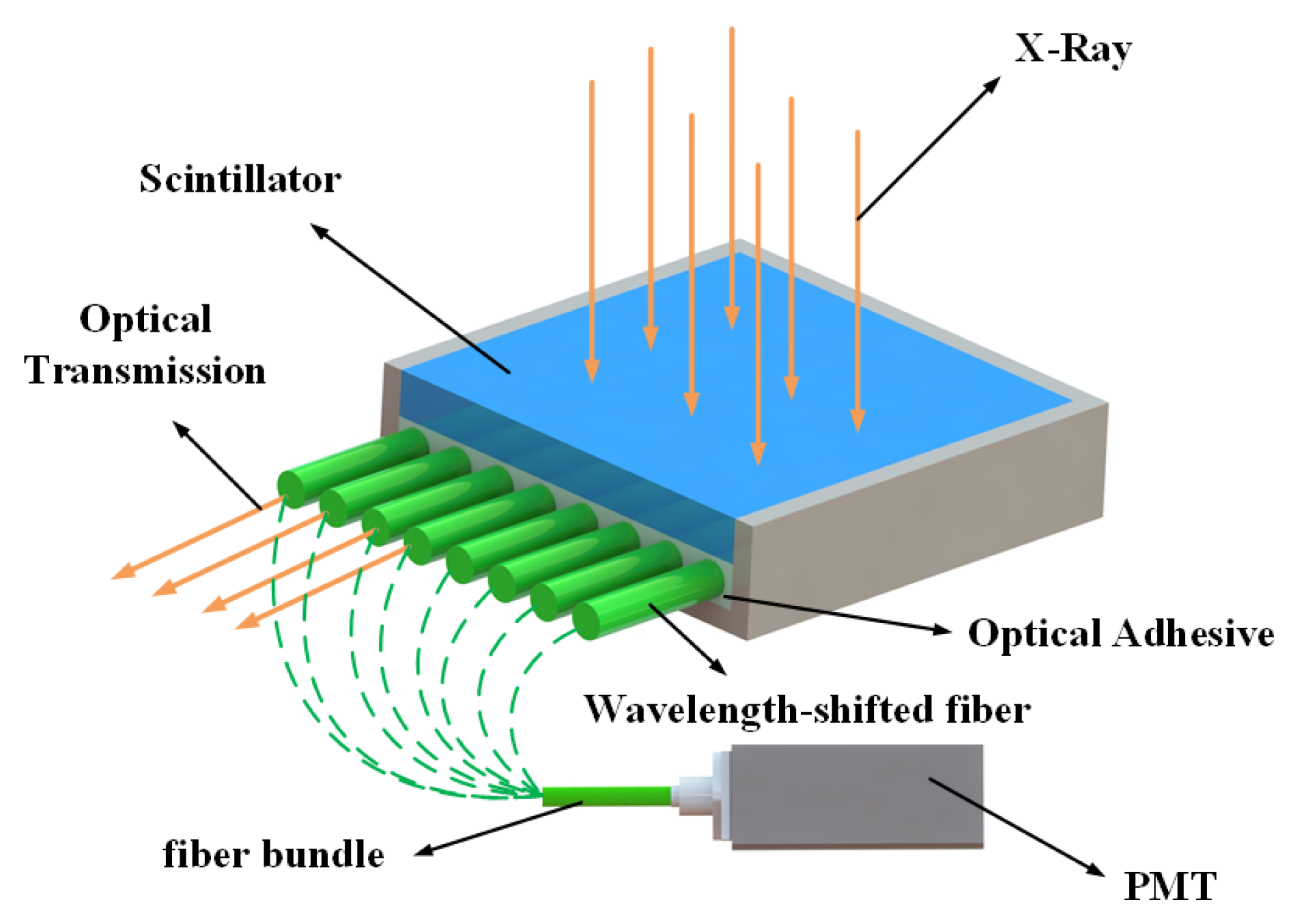
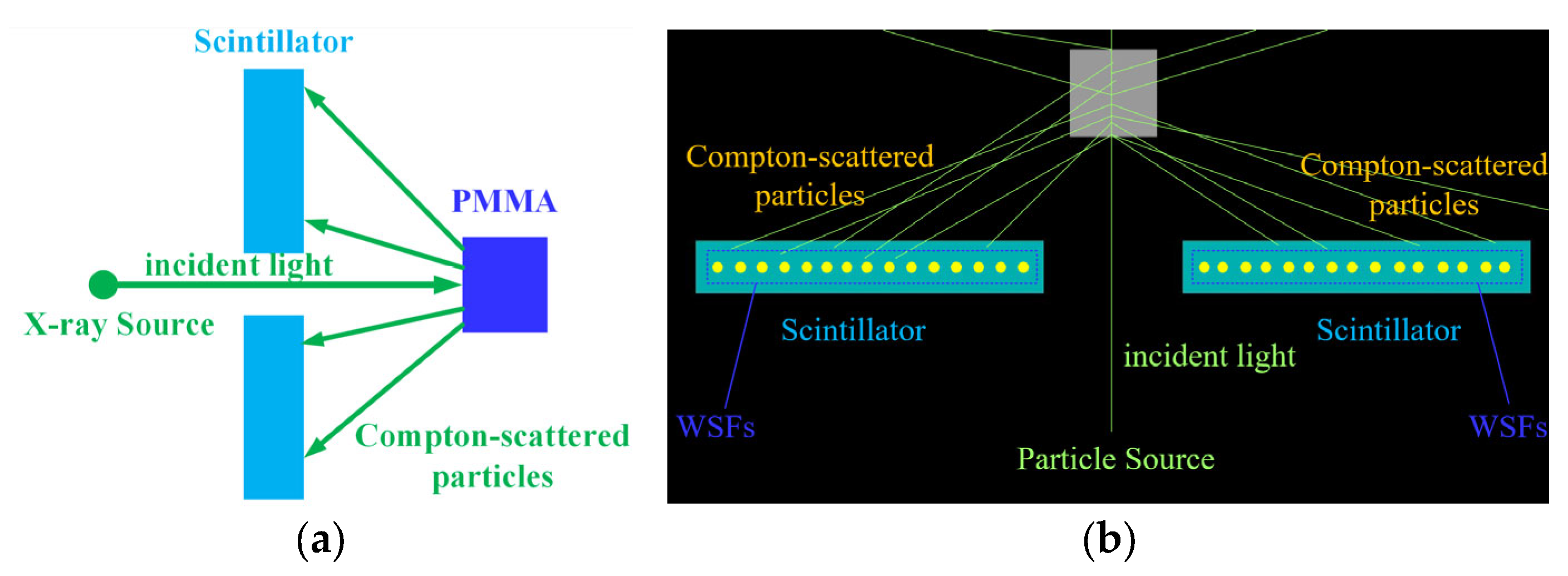

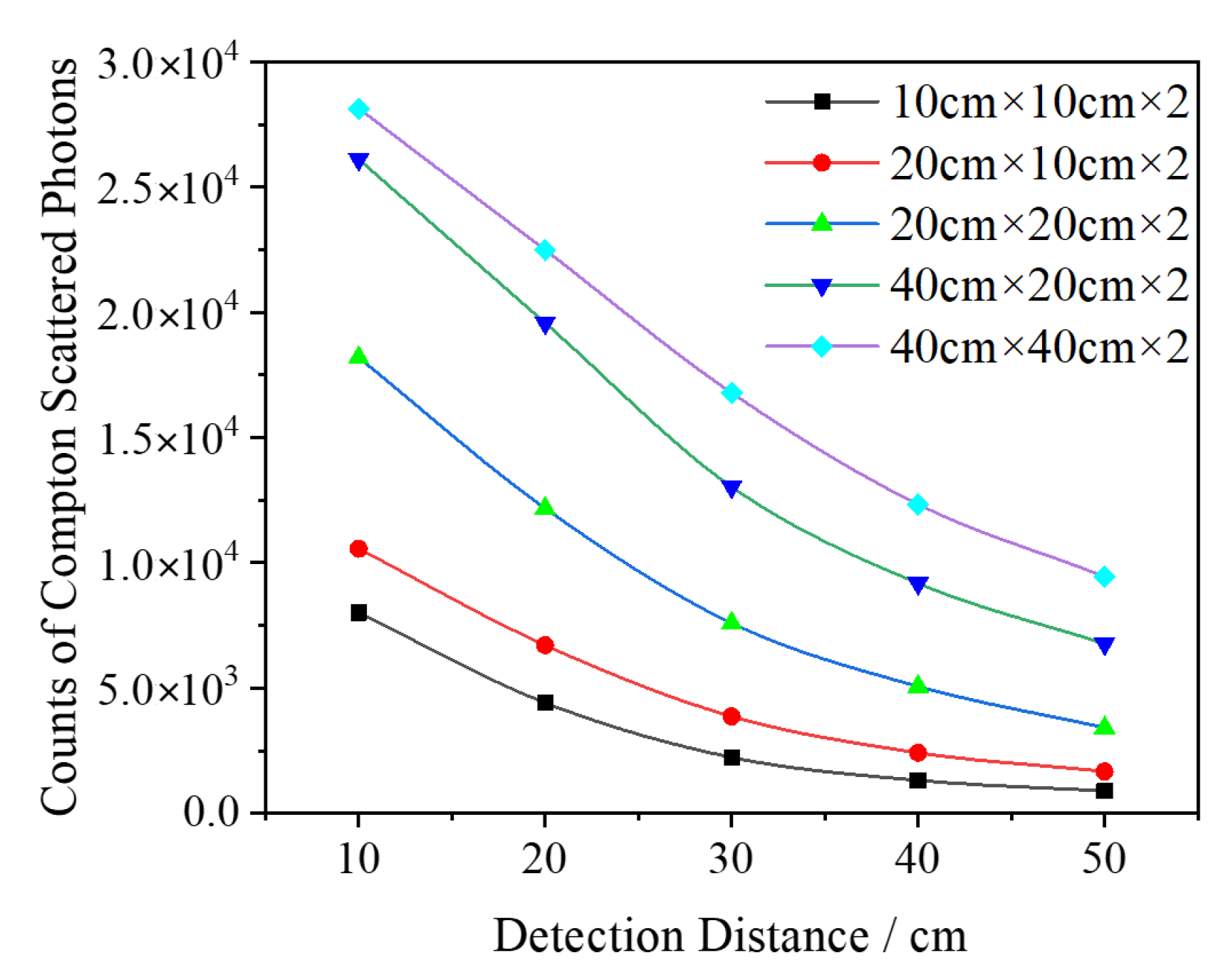
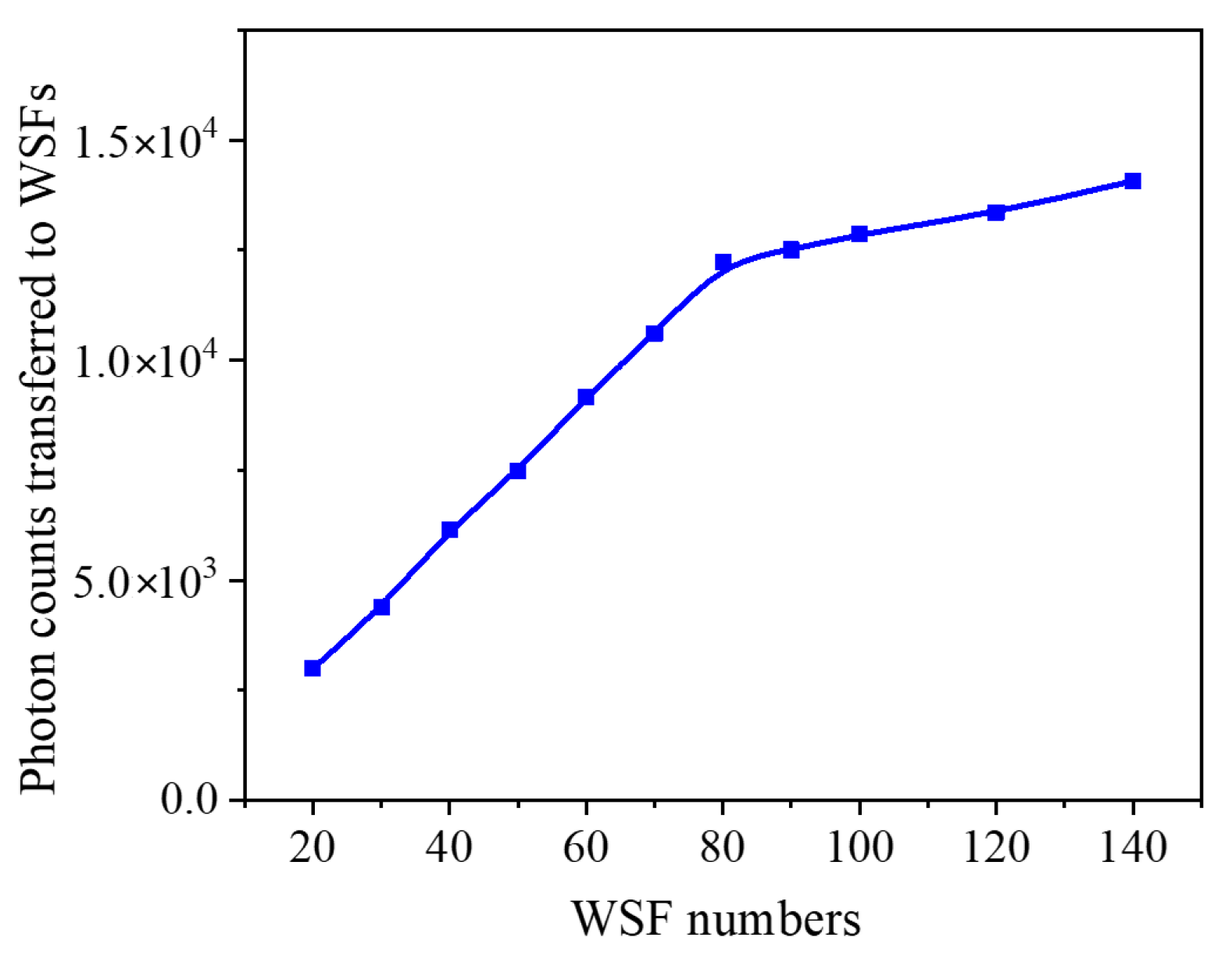
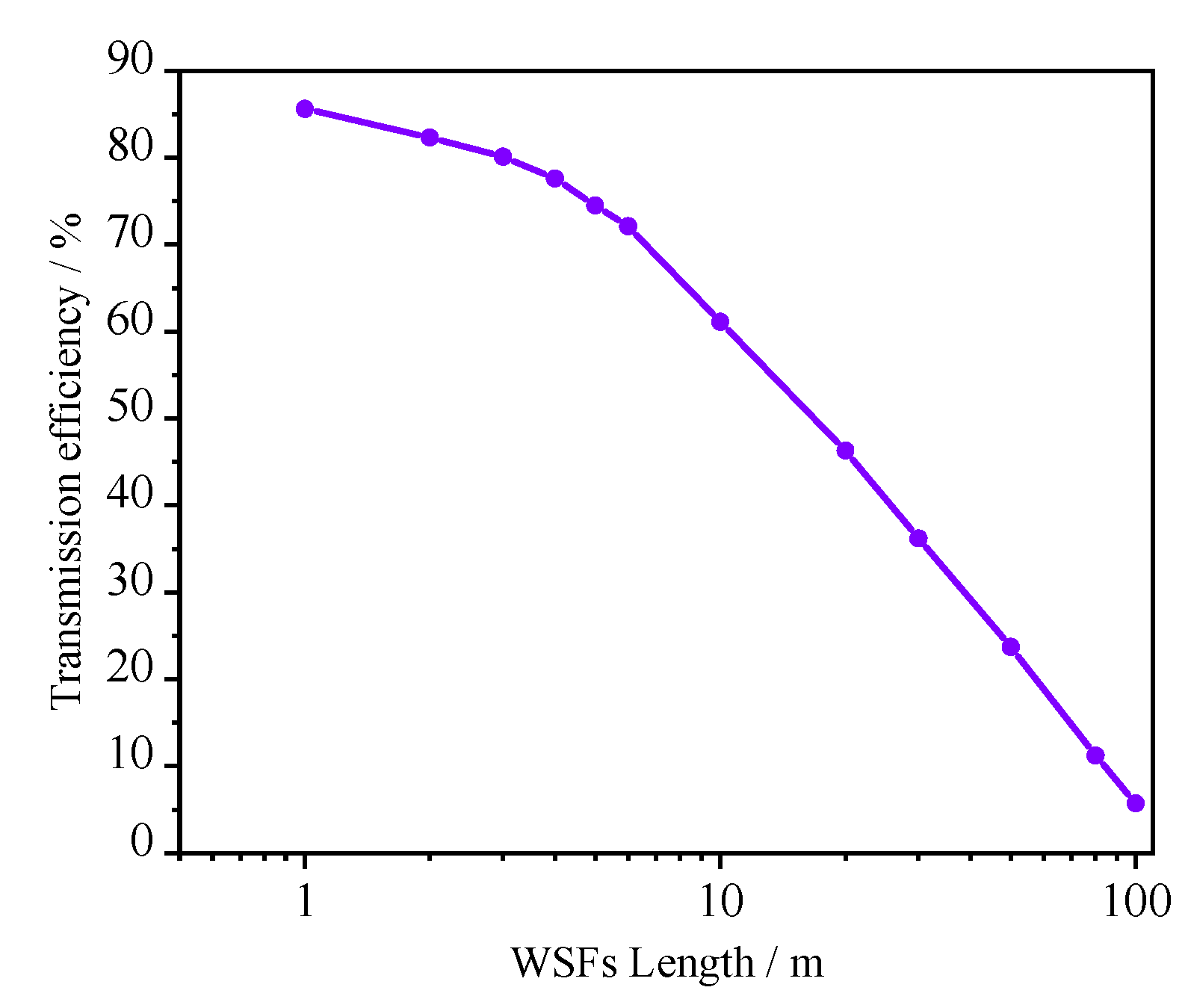
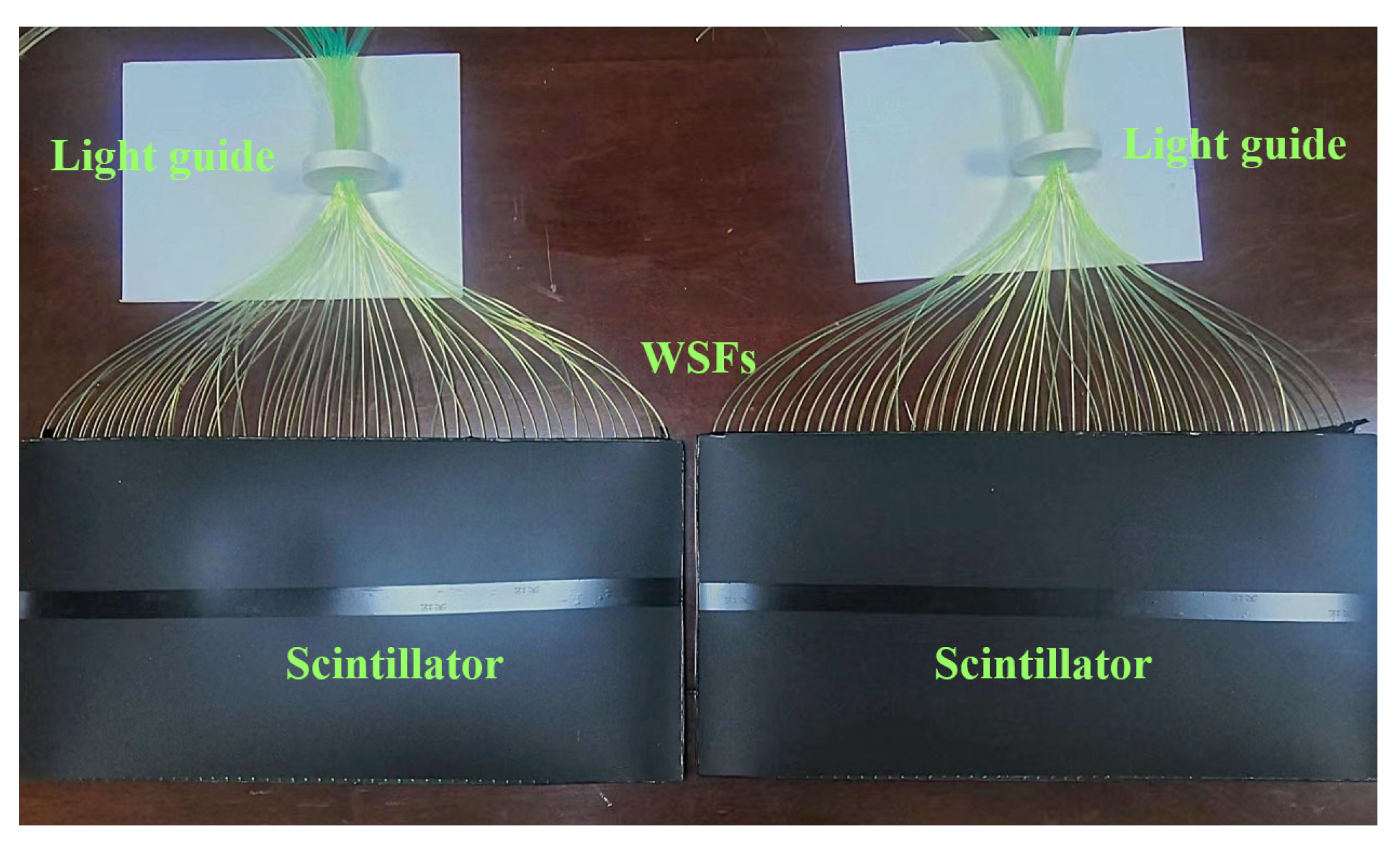
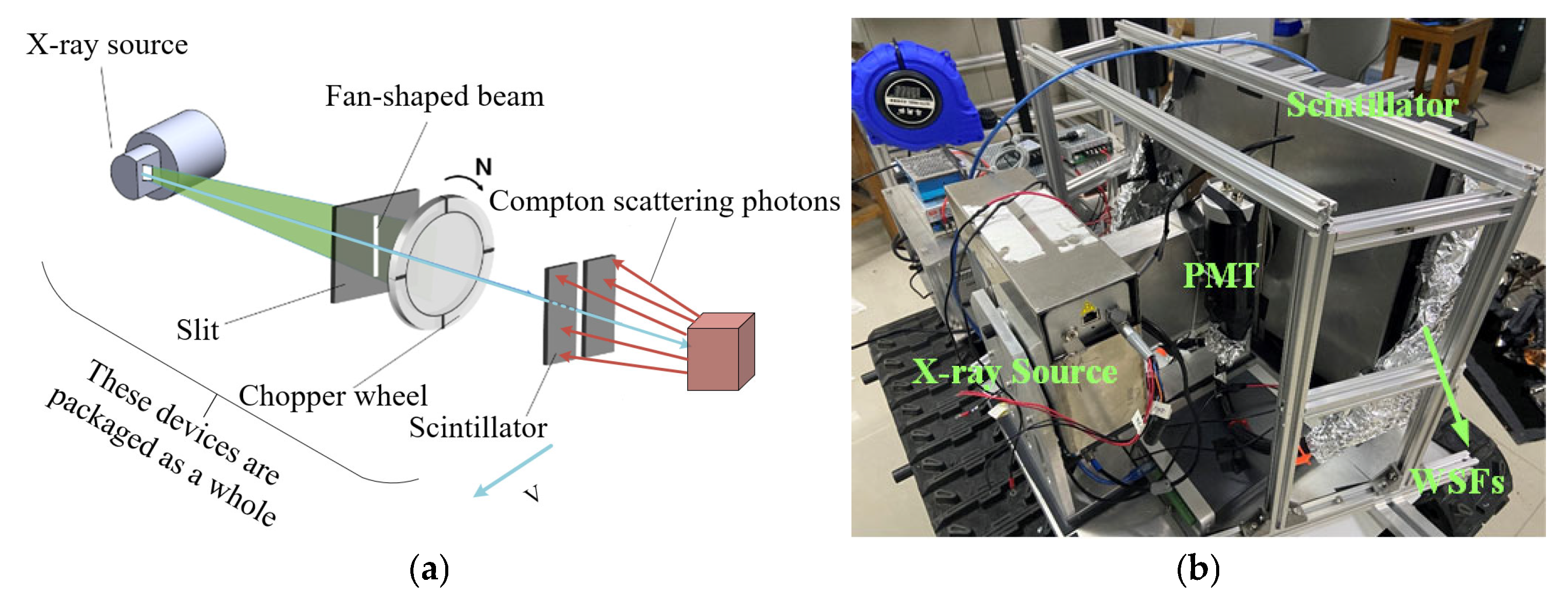
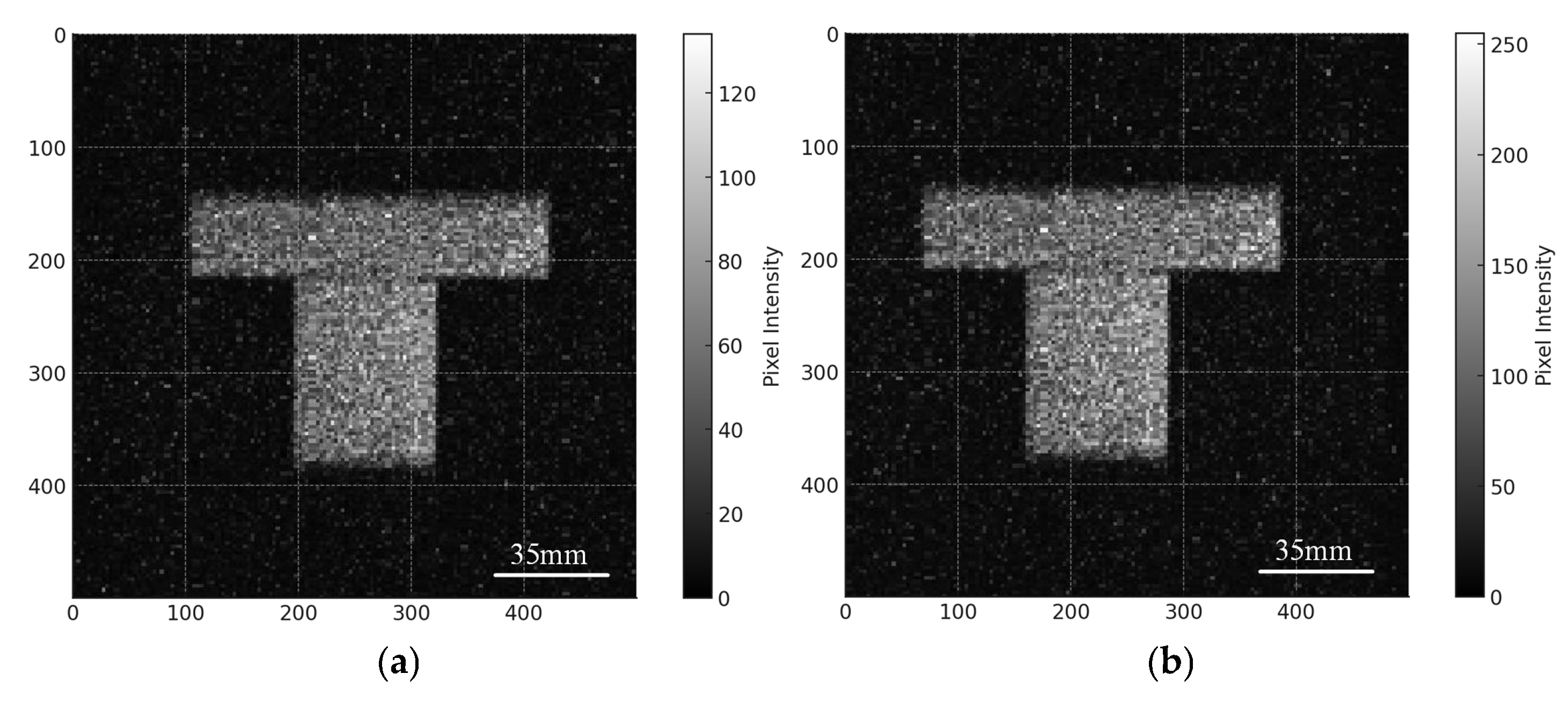
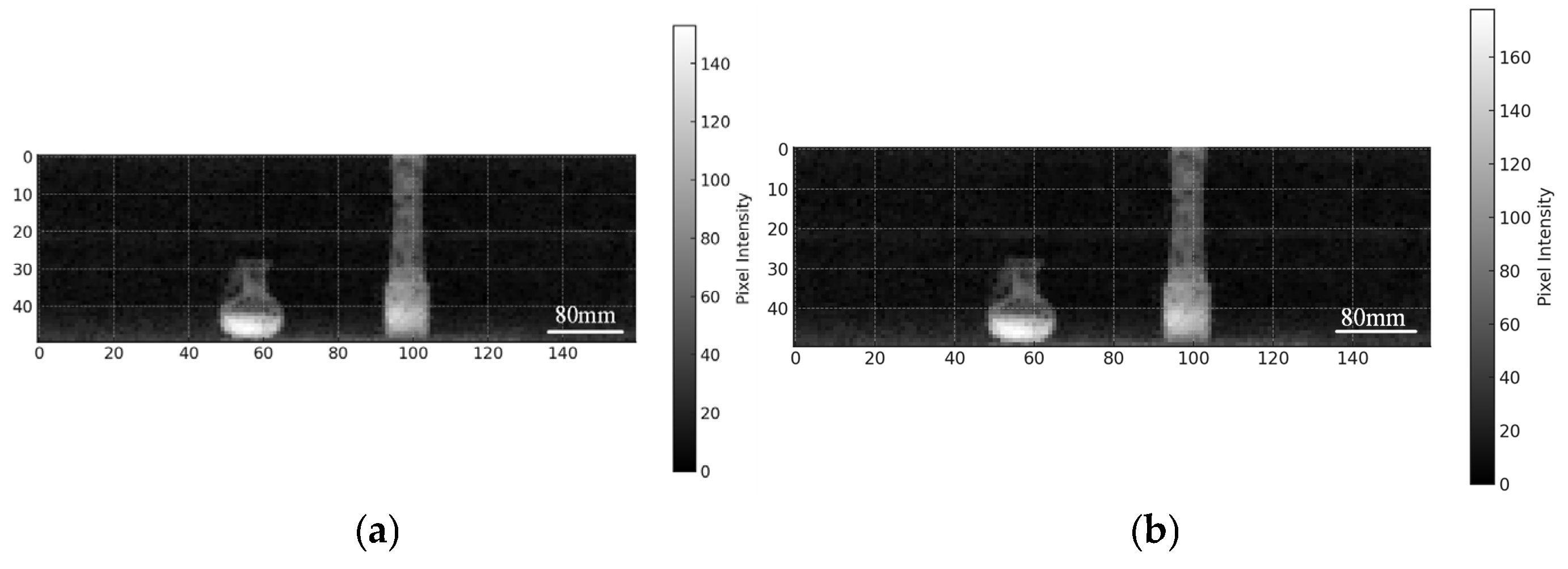
| Feature | PMT with Organic Plastic Scintillators | SiPM with Inorganic Scintillators | WSF Scintillator Method |
|---|---|---|---|
| Photon Transmission | Loss due to PMT mismatch | Limited by SiPM area and inefficiencies | Optimized via WSF and epoxy coupling |
| Coupling Efficiency | Low efficiency | High efficiency | High efficiency with epoxy resin |
| Size and Weight | Large, bulky due to PMT | Small, Limited by the SiPM area | Compact, flexible design |
| Photon Yield | 8000~12,000 photons/MeV (e.g., Polystyrene) | 20,000–60,000 photons/MeV (e.g., LYSO) | 8000~12,000 photons/MeV (e.g., Polystyrene) |
| Applications | Security and nuclear detection | Portable/medical systems | High-res, high-sensitivity imaging |
| WSF Numbers | WSF Photon Count | Transmission Efficiency | Epoxy-Resin-Enhanced WSF Photon Count | Transmission Efficiency |
|---|---|---|---|---|
| 20 | 2994 | 1.06% | 41,947 | 14.86% |
| 30 | 4390 | 1.55% | 43,274 | 15.33% |
| 40 | 6145 | 2.17% | 45,278 | 16.04% |
| 50 | 7494 | 2.65% | 47,169 | 16.71% |
| 60 | 9156 | 3.24% | 51,488 | 18.24% |
| 70 | 10,612 | 3.76% | 53,295 | 18.88% |
| 80 | 12,231 | 4.33% | 54,847 | 19.43% |
| 90 | 12,507 | 4.43% | 55,327 | 19.60% |
| 100 | 12,866 | 4.56% | 55,864 | 19.79% |
| Feature | Flying Spot Scanning (FSS) | Lobster Eye Technology | Coded Aperture Technology |
|---|---|---|---|
| Resolution | 1–2 mm (high resolution) | 5 mm to 1 cm (lower resolution) | 1–10 mm (moderate resolution) |
| Sensitivity | High | Weak | Moderate |
| Data Processing | Difficult: requires the reconstruction algorithm | Easy: generates two-dimensional images directly | Difficult: requires decoding of the mask pattern |
| System Size | Both small and large sizes are available | Small due to reflective surfaces | Small: compact with no moving parts |
| Energy | High-energy and low-energy compatibility | Low energy | High-energy and low-energy compatibility |
Disclaimer/Publisher’s Note: The statements, opinions and data contained in all publications are solely those of the individual author(s) and contributor(s) and not of MDPI and/or the editor(s). MDPI and/or the editor(s) disclaim responsibility for any injury to people or property resulting from any ideas, methods, instructions or products referred to in the content. |
© 2025 by the authors. Licensee MDPI, Basel, Switzerland. This article is an open access article distributed under the terms and conditions of the Creative Commons Attribution (CC BY) license (https://creativecommons.org/licenses/by/4.0/).
Share and Cite
Yang, B.; Yang, Z.; Wang, X.; Mu, B.; Xu, J.; Yang, C.; Li, H. Research on Wavelength-Shifting Fiber Scintillator for Detecting Low-Intensity X-Ray Backscattered Photons. Photonics 2025, 12, 567. https://doi.org/10.3390/photonics12060567
Yang B, Yang Z, Wang X, Mu B, Xu J, Yang C, Li H. Research on Wavelength-Shifting Fiber Scintillator for Detecting Low-Intensity X-Ray Backscattered Photons. Photonics. 2025; 12(6):567. https://doi.org/10.3390/photonics12060567
Chicago/Turabian StyleYang, Baolu, Zhe Yang, Xin Wang, Baozhong Mu, Jie Xu, Cheng Yang, and Hong Li. 2025. "Research on Wavelength-Shifting Fiber Scintillator for Detecting Low-Intensity X-Ray Backscattered Photons" Photonics 12, no. 6: 567. https://doi.org/10.3390/photonics12060567
APA StyleYang, B., Yang, Z., Wang, X., Mu, B., Xu, J., Yang, C., & Li, H. (2025). Research on Wavelength-Shifting Fiber Scintillator for Detecting Low-Intensity X-Ray Backscattered Photons. Photonics, 12(6), 567. https://doi.org/10.3390/photonics12060567





